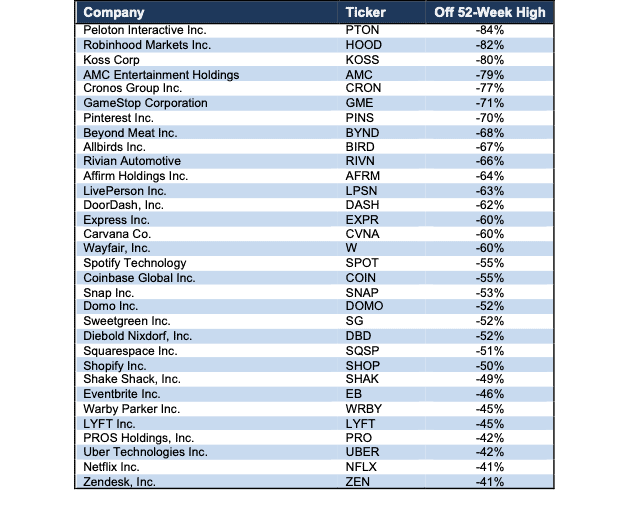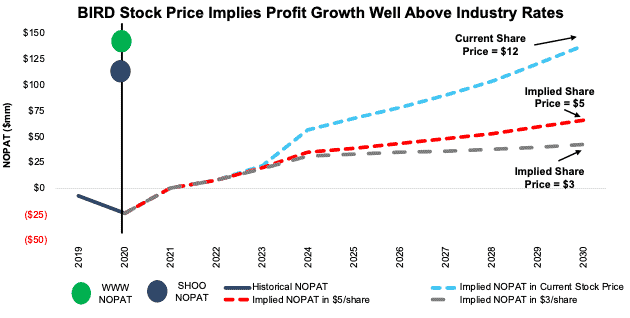We published an update on BIRD on October 17, 2022. A copy of the associated report is here.
We counsel investors not to try and catch falling knives – stocks that have seen steep declines but still have further to fall. As the market rotates away from high-flying growth names to more stable cash generators, investors need reliable fundamental research, more than ever, to protect their portfolios from falling knives.
We continue to post an exceptional hit rate on spotting overvalued stocks. Currently, 62 out of our 65 Danger Zone stock picks are down from their 52-week highs by more than the S&P 500. Figure 1 lists the open Danger Zone picks that are down at least 40% from their 52-week highs. Our Focus List Stocks: Short Model Portfolio, the best-of-the-best of our Danger Zone picks, outperformed the S&P 500 as a short portfolio by 36% in 2021 with 29 out of our 31 picks outperforming the index.
This report highlights one particularly dangerous falling knife: Allbirds (BIRD: $12/share). We highlight four other falling knives in other reports published today: Sweetgreen (SG: $31/share) here, Carvana (CVNA: $150/share) here, Wayfair (W: $140/share) here, and Shake Shack (SHAK: $64/share) here. Each of these stocks have dropped at least 40% from all-time highs, yet still carry at least 40% additional downside risk.
Figure 1: Danger Zone Picks Down >40% From 52-Week High – Performance through 2/4/22
Sources: New Constructs, LLC
Falling Knife: Allbirds (BIRD): Down 65% from 52-Wk High & 75%+ Downside Remaining
We put Allbirds in the Danger Zone in in September 2021 prior to its IPO. Since the opening price on IPO date, the stock is down 46% while the S&P 500 is up 1%, and Allbirds’ shares could fall another 75%. We detail Allbirds’ unprofitable and increasingly costly business model, strong competition, and poor fundamentals in our report here.
Allbirds Is Priced to Grow Revenue by 5x
Below, we use our reverse discounted cash flow (DCF) model to analyze the expectations for future growth in cash flows baked into Allbirds’ current share price and show that it could fall 75%+ further. Note that Allbirds has yet to report its fourth quarter earnings.
To justify its current price of $12/share, Allbirds must:
- improve its NOPAT margin to 0% in 2021 (compared to -11% 2020), 2% in 2022, 5% in 2023, and 11% (midpoint of Nike’s and Sketchers’ TTM margins) from 2024-2030 and
- grow revenue by 19% (vs. 13% in 2020) compounded annually for the next ten years, which is over 8x the expected industry growth rate through 2026.
In this scenario, Allbirds would generate nearly $1.3 billion in revenue in 2030, which is 5x its 3Q21 revenue when annualized. In a mature, largely undifferentiated shoe and apparel market, the ability to grow 8x above industry rates implies huge market share gains. The stock’s valuation also implies significant improvement in profitability, to levels above Skechers (SKX). Essentially, investors in Allbirds are betting the company can take market share and improve profitability at the same time in a hyper-competitive market.
Given that Allbirds’ reported operating margin declined from -14% to -15% year-over-year (YoY) in the nine months ended September 30, the assumed margin improvement in this scenario looks highly unlikely. Companies that grow revenue by anywhere near 20%+ compounded annually for such a long period are also unbelievably rare, which make the expectations in Allbirds’ share price even more unrealistic.
58% Downside If Growth Just Exceeds 2020 Levels
We review an additional DCF scenario to highlight the downside risk should Allbirds’ revenue grow at 6x the projected industry growth rate.
If we assume Allbirds:
- improves its NOPAT margin to 0% in 2021, 2% in 2022, 5% in 2023, and 8% (average of Skechers and Wolverine World Wide’s TTM margins) from 2024-2030 and
- grows revenue by 14% (vs. 13% in 2020) compounded annually from 2021-2030, then
Allbirds is worth just $5/share today – a 58% downside.
75% Downside Even if Allbirds Triples Long-Term Industry Growth Rate
We review a final DCF scenario to highlight the downside risk should Allbirds’ grow revenue three times as fast as industry expectations, given that it is starting from such a small base.
If we assume Allbirds:
- improves its NOPAT margin to 0% in 2021 (compared to -11% TTM), 2% in 2022, 5% in 2023, and 8% from 2024-2030 and
- grows revenue by 9% (3x projected industry growth through 2026) compounded annually from 2021-2030, then
the stock is worth just $3/share today – a 75% downside.
Figure 2 compares Allbirds implied future NOPAT in these scenarios to its NOPAT, along with the NOPAT of peers Wolverine World Wide (WWW) and Steve Madden (SHOO).
Figure 2: Allbirds’ Historical and Implied NOPAT: DCF Valuation Scenarios
Sources: New Constructs, LLC and company filings
Each of the above scenarios also assumes Allbirds grows revenue, NOPAT, and FCF without increasing working capital or fixed assets. This assumption is highly unlikely given the firm’s plans to ramp up its brick-and-mortar presence but allows us to create best-case scenarios that demonstrate the expectations embedded in the current valuation. For reference, Allbirds’ invested capital nearly doubled from $83 million in 2019 to $160 million in 2020. If we assume Allbirds’ invested capital increases at a similar rate in DCF scenarios 2 and 3 above, the downside risk is even larger.
Fundamental Research Provides Clarity in Frothy Markets
2022 has quickly shown investors that fundamentals matter and stocks don’t only go up. With a better grasp on fundamentals, investors have a better sense of what and when to buy and sell – and – know how much risk they take when they own a stock at certain levels. Without reliable fundamental research, investors have no reliable way of knowing whether a stock is expensive or cheap.
As shown above, disciplined, reliable fundamental research shows that even after plummeting, Allbirds, Sweetgreen, Carvana, Wayfair, and Shake Shack still hold significant downside.
This article originally published on February 7, 2022.
Disclosure: David Trainer, Kyle Guske II, and Matt Shuler receive no compensation to write about any specific stock, style, or theme.
Follow us on Twitter, Facebook, LinkedIn, and StockTwits for real-time alerts on all our research.


